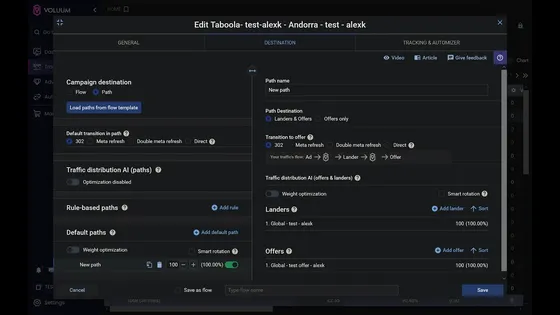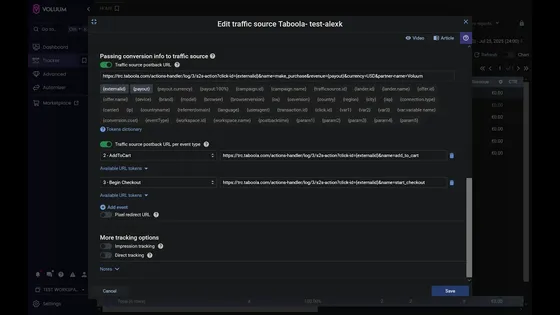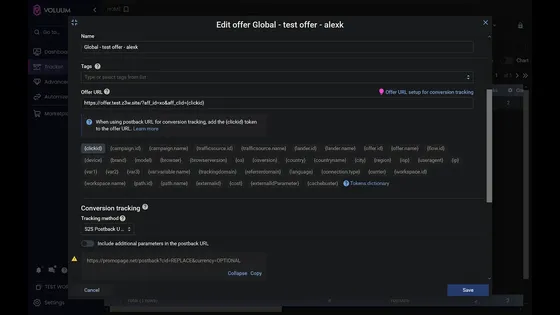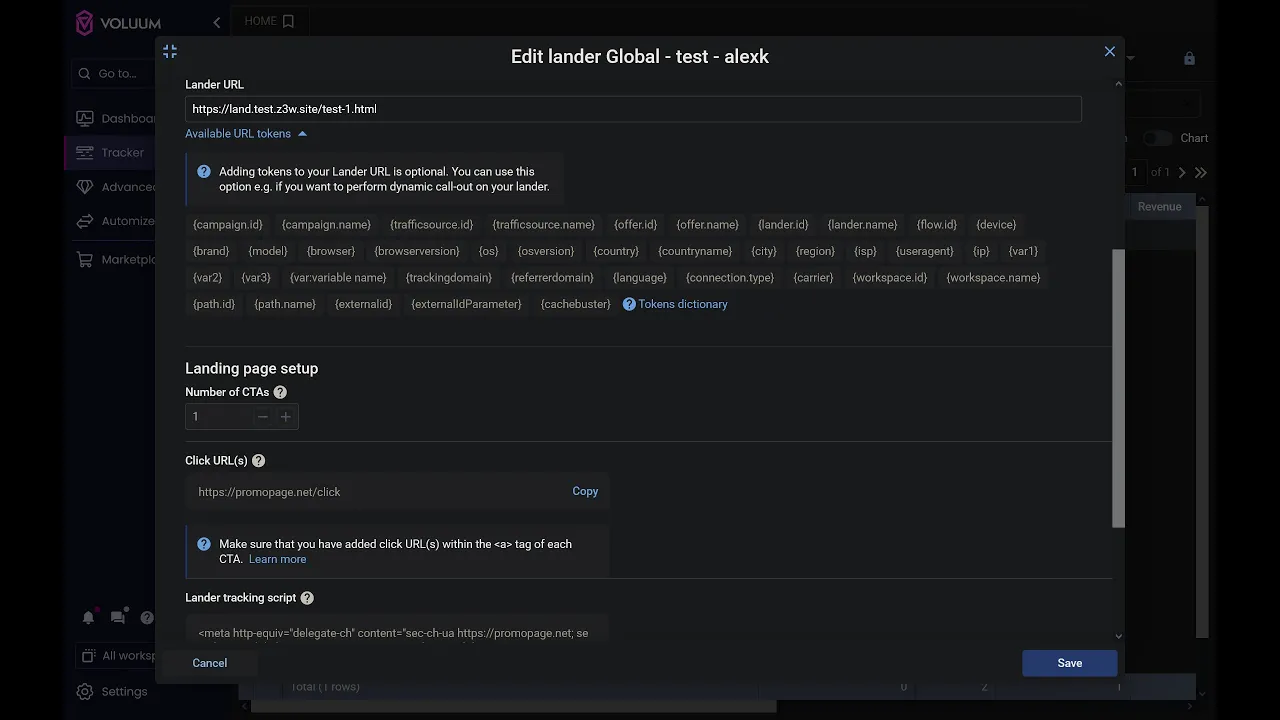Voluum Tracking Campaign Setup
In this tutorial, we will create a tracking campaign based on Voluum TDS. There's a lot of such traffic distribution systems on a market, like Keitaro, Binom, RedTrack, etc. Each of them performs the same function of traffic distribution, but at the same time, has its own characteristics, options and specific settings. For example, Keitaro and Binom is selfhosted platforms.
More about: Tracking
Traffic Source
Voluum has a lot of traffic source templates, like Taboola(Realize), Outbrain, MGID, Revcontent, NewsBreak, MediaGo. In most cases you need to create it from existing template and set only conversion postbacks for required source, without setting namings for parameters and tokens. And this postbacks depends of your conversion events names and S2S request formats for each of advertising platforms.
More about: Custom Traffic Sources.
Offer Page
What is an Offer Page in case of tracking? Offer URL is a final "user journey" destination page. It can be the shopping cart, the checkout form, sale page, Shopify product page, the app store download page, etc. You need to request the offer page URL from the client and setup conversion postbacks with a client platform.
Before creating a new offer page URL in Voluum, you need to understand URL structure to be able to append tracking parameters to the link correctly. You need to know the meaning of the ?, &, # symbols in the URL, otherwise you can "break" the link.
?utm_source={trafficsource.name}&utm_medium=xo&utm_term={clickid}More about: Tracking, Parameters.
Lander
If you're going to use "Redirect method"(which you probably will) for transitioning between ad and campaign funnel, so in general it's required and enough to set https://your-voluum.domain/click URL for all of your land CTA links.
And it's good practice to add a JavaScript tracking code to the landing page html head tag, to be able to redirect and track organic traffic and avoid Error 400 Bad Request. You can get this code on the campaign creation step. It's important to know, that "organic tracking script", it's not the same as "direct tracking script".
The main thing you need to know about choosing a correct domain for your landings+scripts and campaigns, that you need to use same domain throughout the entire tracking funnel. Which means, if you set
https://your-voluum.domain/clickurl for landing CTA's, so you need to use sameyour-voluum.domainfor your tracking script and sameyour-voluum.domainfor your tracking campaign link.
More about: How to Add Click URLs to Lander
Tracking Campaign
To create a simple campaign, it's enough a Traffic Source and Offer Page. You can add a Landing Page after full tracking campaign setup. This is useful, for example, when you need to provide a tracking link to run some integration tests or make a test conversion event to make sure, that the client's S2S postbacks are correct.
Tests
MeasureTest twice, cut once.
We work in a field where sometimes one extra character can lead to a big loss of traffic and money.
So Test Test Test! Before you're going live with ad campaign. After you're making changes. If you're not sure of don't remember. Just make a test.
It's good to have a separate web browser with default settings and without any 3-d party extensions for testing purposes. Clear browsing data(cookies, cache and other sites data) before each test.
It is much more effective to detect and fix an error before it causes damage than to look for those responsible for that damage later. 😉
Conversion Events Settings
The main purpose of setting up conversion events is to send the ad click ID from Traffic Source to your TDS, then send a user click ID from TDS to the customer product platform and receive it back from the customer when a user conversion occurs. It can be sale, initial checkout, add to cart events, etc.

As a media buyer, you need to understand the fundamental principles behind conversion events. This can save you a lot of time, and for senior media buyers, this basic knowledge is essential.
Also, sending conversion events is possible via JavaScript Pixel codes(or even an image pixel) with each of advertising platforms, but it's not covered in this tutorial because this is about advanced tracking and S2S postbacks.
Ad Campaign Setup
On this stage, you need to setup additional parameters for your campaign tracking link(like ad click id, cost per click, ad campaign name, etc.) and a traffic source conversion events with their namings.
It's good practice to separate your ad link from tracking parameters. So you can change tracking parameters without your campaign ads re-moderation and tracking params will be added to all of your ad links.
Make sure your ad campaign tracking link contains the ad click ID token, otherwise you will not be able to send S2S conversion events postbacks to optimize your ad campaign.
More about: Taboola Campaign URL Parameters for Tracking, Defining Taboola Conversions
S2S Postbacks
In general, there's 2 types of postbacks:
Incoming - from Offer Page Platform to your TDS.
Example of default conversion event S2S postback for Voluum.
Example of custom purchase event S2S postback for Voluum.https://your-voluum.domain/postback?cid={clickid}
Where:https://your-voluum.domain/postback?cid={clickid}&et=purchase&payout={product_price}&txid={order_id}cid={clickid}- tracker click ID; required;et=purchase- custom event name;payout={product_price}- revenue amount per conversion;txid={order_id}- unique transaction ID;
Make sure, that your offer platform sends S2S conversion event postbacks to your tracker.
More about: Voluum Postback Parameters
Outcoming - from your TDS to Traffic Source Platform.
Examples of purchase event S2S postback by platforms:
Taboola:
Outbrain:https://trc.taboola.com/actions-handler/log/3/s2s-action?click-id={externalid}&name=Purchase&revenue={payout}¤cy=USD
Revcontent:https://tr.outbrain.com/pixel?ob_click_id={externalid}&name=Purchase&orderValue={payout}¤cy=EUR
NewsBreak:https://trends.revcontent.com/api/v1/conversion.php?api_key=[ACCOUNT_API_KEY]&uuid={externalid}&amount={payout}&user_ip={ip}&user_agent={useragent}
MGID:https://business.newsbreak.com/tracking/attribute?callback={externalid}&nb_value={payout}&event_type=complete_paymenthttps://a.mgid.com/postback/[ACCOUNT_ID]?c={externalid}&r={payout}&e=PurchaseKeep in mind that it takes some time (usually a few hours, but sometimes a day) from the time a conversion occurs until it shows up in your traffic source reports.
One more thing you need to know: you cannot do a test S2S postback to show up in some traffic sources reports before your ad campaign is going live.




